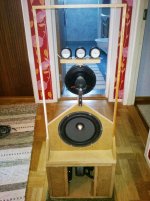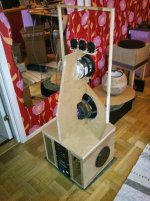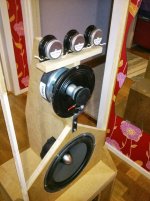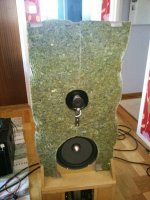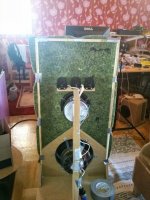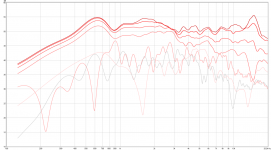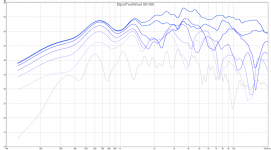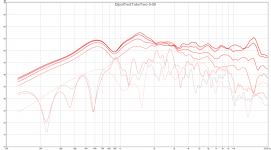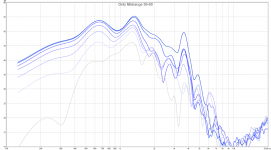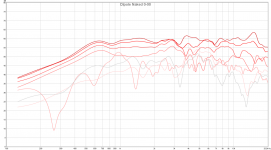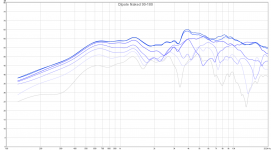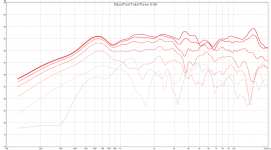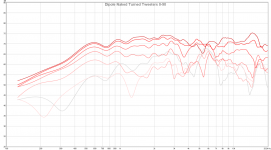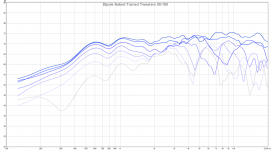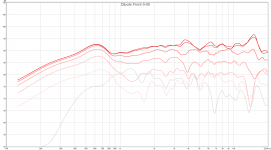What would interest me is how this would work full range, say you took a Nao Note 2 RS or a LX521 where both are designed in the small-driver with small baffles methodology:
What if you slabbed extra wool baffles around it, would you get free efficiency or would there be a tradeoff?
My own next experiment is to scale up to the real thing with a woofer mid and tweeters integrated and test a full range response from 100 - 20 000 and see if it still looks promising.
What if you slabbed extra wool baffles around it, would you get free efficiency or would there be a tradeoff?
My own next experiment is to scale up to the real thing with a woofer mid and tweeters integrated and test a full range response from 100 - 20 000 and see if it still looks promising.
i would also be interested in how the wool baffle affects the dispersion characteristics compared to the wooden baffle.
the reason for the slim baffles of the nao note and lx521 is the excellent directivity.
the reason for the slim baffles of the nao note and lx521 is the excellent directivity.
Soon it is time for the next experiment, here is how the speaker looks like without any wool:
The plan is to mount wool out to the outer frame. The reason for 3 tweeters on the back is that the rear dispersion of the midrange is not as good as the front dispersion, so they will help from 1400 hz and upwards. The front coaxialish tweeter will be crossed somewhere in between 2000 - 3000 hz I think.
Now that I'm thinking about it it might be more simple to use 4 tweeters on the back, that would simplify the front/back crossover since then I impedance wise could see it as one tweeter on the back, just one with far more output capability.
In the end I will do this draft speaker and then compare it to an omni version and listen and see which I prefer more, and then build another one of that type.
The plan is to mount wool out to the outer frame. The reason for 3 tweeters on the back is that the rear dispersion of the midrange is not as good as the front dispersion, so they will help from 1400 hz and upwards. The front coaxialish tweeter will be crossed somewhere in between 2000 - 3000 hz I think.
Now that I'm thinking about it it might be more simple to use 4 tweeters on the back, that would simplify the front/back crossover since then I impedance wise could see it as one tweeter on the back, just one with far more output capability.
In the end I will do this draft speaker and then compare it to an omni version and listen and see which I prefer more, and then build another one of that type.
Attachments
I would try mounting the 3 wool sheets in a long cone-shaped frame behind the driver ... similar to the B&W Nautilus but with a lossy wall structure.
Part of the reason the lossy material behaves differently is the phase relation between the front wave and rear wave; the wool acts both as a resistance and a low-pass filter, which shifts the phase of the rear wave, as well as preventing a complete null at very low frequencies. (You have to use vector math to acoustically sum the front and rear waves at the listening position, so the phase relation between the two waves matters.)
With a solid baffle or no baffle at all, the response function is dominated by the transit time around the driver between the front and rear waves. With the wool baffle, there's the expected transit time around and through the baffle, but there's also several dB of attenuation and additional phase rotation from the acoustical lowpass function of the wool. This results in a less deep null at the lowest frequencies as well as much less baffle peak (both of which require an exact phase relation of zero degrees for a total null and 180 degrees for 6 dB of peaking).
It only takes a few dB of attenuation to avoid the deep nulls and peaking, and that's what the wool is doing. The additional phase rotation is also desirable, since it prevents the single-frequency peaking of a solid-wall baffle (or no baffle at all).
This is why I think a multi-layer wool cone that was 0.5 meter or more long might give even better results, since there would be even more attenuation of the rear wave, but little or no internal reflection from the interior of the cone (which is a problem with the B&W Nautilus approach). There's also nothing stopping you from filling the interior of the wool cone with additional damping material, if you wish, which would further attenuate the rear wave.
If you can attain 10 dB or more of attenuation, your driver will start to behave more like an ideal infinite-baffle, with no definable box volume or internal reflections.
From an impulse response standpoint, that is greatly superior to an open-baffle, which always has the annoying rear-wave wrapping around the front, which results in a delayed and phase-inverted signal added to the first-arrival signal. (I should add that frequency-based equalization does not remove this additional signal; that would take time-based digital FIR equalization, and that's only accurate for one position in space.)
Part of the reason the lossy material behaves differently is the phase relation between the front wave and rear wave; the wool acts both as a resistance and a low-pass filter, which shifts the phase of the rear wave, as well as preventing a complete null at very low frequencies. (You have to use vector math to acoustically sum the front and rear waves at the listening position, so the phase relation between the two waves matters.)
With a solid baffle or no baffle at all, the response function is dominated by the transit time around the driver between the front and rear waves. With the wool baffle, there's the expected transit time around and through the baffle, but there's also several dB of attenuation and additional phase rotation from the acoustical lowpass function of the wool. This results in a less deep null at the lowest frequencies as well as much less baffle peak (both of which require an exact phase relation of zero degrees for a total null and 180 degrees for 6 dB of peaking).
It only takes a few dB of attenuation to avoid the deep nulls and peaking, and that's what the wool is doing. The additional phase rotation is also desirable, since it prevents the single-frequency peaking of a solid-wall baffle (or no baffle at all).
This is why I think a multi-layer wool cone that was 0.5 meter or more long might give even better results, since there would be even more attenuation of the rear wave, but little or no internal reflection from the interior of the cone (which is a problem with the B&W Nautilus approach). There's also nothing stopping you from filling the interior of the wool cone with additional damping material, if you wish, which would further attenuate the rear wave.
If you can attain 10 dB or more of attenuation, your driver will start to behave more like an ideal infinite-baffle, with no definable box volume or internal reflections.
From an impulse response standpoint, that is greatly superior to an open-baffle, which always has the annoying rear-wave wrapping around the front, which results in a delayed and phase-inverted signal added to the first-arrival signal. (I should add that frequency-based equalization does not remove this additional signal; that would take time-based digital FIR equalization, and that's only accurate for one position in space.)
Last edited:
I'm a complete novice at speaker design but find this thread very interesting and can't help but dive in.
Do you mean like the Nautilus Prestige? So having a narrow wool cone (three layers thick) with the cone of the driver facing right out the end of the cone?
If so, seems like you'd want the wool thickness to be proportional to the driver size to increase the low-frequency effectiveness of the phase rotation / attenuation for larger drivers, right? Which is easy since a larger driver allows for a larger wool cone, and plenty of volume to fill with Acoustastuf or fluffy wool.
Also, seems like rear-mounting tweeters like OldBoll's design might be necessary to preserve the rear-wave spectral distribution? Otherwise you'd have a really muffled rear wave (from the wool) with lots of low to mid energy that seems like it would artificially darken the timbre of room reflections from the backwave.
similar to the B&W Nautilus but with a lossy wall structure.
Do you mean like the Nautilus Prestige? So having a narrow wool cone (three layers thick) with the cone of the driver facing right out the end of the cone?
If so, seems like you'd want the wool thickness to be proportional to the driver size to increase the low-frequency effectiveness of the phase rotation / attenuation for larger drivers, right? Which is easy since a larger driver allows for a larger wool cone, and plenty of volume to fill with Acoustastuf or fluffy wool.
Also, seems like rear-mounting tweeters like OldBoll's design might be necessary to preserve the rear-wave spectral distribution? Otherwise you'd have a really muffled rear wave (from the wool) with lots of low to mid energy that seems like it would artificially darken the timbre of room reflections from the backwave.
Thank you for the experiment and measurements!
I think that the wool and wood may look opaque to us but they are transparent in various degrees to sound. The theoretical and software models for open baffles are based on opaque baffles. With an opaque baffle you should get a much greater difference in the frequencies of peaks and null between naked and with baffles and the graphs do not show such a thing, being highly correlated in all three variants at around 700 Hz.
The transparency of the baffle is like a diffuser for the waves going thru the baffle to the other side, which add with the wave going around the baffle and alter the theoretical response. I expect the wool to be a better diffuser and maybe this is the cause of the smoothing.
I also think that the wood baffle vibrates and radiates itself a little. Maybe that deep null at around 1300Hz is not only from the dipole caused by that wood baffle resonance? If you get such a null from the dipole only I think that at 90 degrees you should have also a big null.
I think that the wool and wood may look opaque to us but they are transparent in various degrees to sound. The theoretical and software models for open baffles are based on opaque baffles. With an opaque baffle you should get a much greater difference in the frequencies of peaks and null between naked and with baffles and the graphs do not show such a thing, being highly correlated in all three variants at around 700 Hz.
The transparency of the baffle is like a diffuser for the waves going thru the baffle to the other side, which add with the wave going around the baffle and alter the theoretical response. I expect the wool to be a better diffuser and maybe this is the cause of the smoothing.
I also think that the wood baffle vibrates and radiates itself a little. Maybe that deep null at around 1300Hz is not only from the dipole caused by that wood baffle resonance? If you get such a null from the dipole only I think that at 90 degrees you should have also a big null.
Progress! I've only tested without and with one sheet now, the plan is to use 2-3 and in the end maybe more around the woofer.
I haven't done any real outside measurements yet but I have played around with the EQ somewhat inside with gated measurements and the results are very promising. Even though it is assymetric front / back the crossover works so the front and back is mostly symmetric. The middle back tweeter and the front tweeter is first order passed at around 3 khz and the outer back tweeters lowpassed here. All tweeters are also second order highpassed at 2 khz. The final crossover values will have to wait until I can do true polar measurements, the tweeters will probably have to be crossed a bit lower.
The only irony is that the rear dispersion @ 1 khz+ measures more flat than the front one 😛
I haven't done any real outside measurements yet but I have played around with the EQ somewhat inside with gated measurements and the results are very promising. Even though it is assymetric front / back the crossover works so the front and back is mostly symmetric. The middle back tweeter and the front tweeter is first order passed at around 3 khz and the outer back tweeters lowpassed here. All tweeters are also second order highpassed at 2 khz. The final crossover values will have to wait until I can do true polar measurements, the tweeters will probably have to be crossed a bit lower.
The only irony is that the rear dispersion @ 1 khz+ measures more flat than the front one 😛
Attachments
Last edited:
Ah, a speaker only a man could love.
😉
=)
The plan is to make the final version somewhat more pretty 😉
The current plan is to make the wool in a large sheet of 3-4 layers and then cover the whole block in black acousticly transparent fabric and then fasten it on afterwards.
Or I might as well test to use a normal fabric with a nice pattern, if I'm lucky it's transparent enough at 500-3000 hz and would make a better looking speaker.
And here are the results:
Gated measurements, and it seems that I'll have to work on that rear dispersion somewhat since the tweeter transition wasn't that beautiful off axis. I think I'll have to cross the extra tweeters at 2nd order instead of 1st order.
The wool seems to scale well though, so I'd say that part is a success.
This makes me think that two push-pull mounted coaxials would make a really good dipole.
Gated measurements, and it seems that I'll have to work on that rear dispersion somewhat since the tweeter transition wasn't that beautiful off axis. I think I'll have to cross the extra tweeters at 2nd order instead of 1st order.
The wool seems to scale well though, so I'd say that part is a success.
This makes me think that two push-pull mounted coaxials would make a really good dipole.
Attachments
Last edited:
Some more tests with different crossover points:
I think the front tweeter must be crossed with 12 dB instead of 6 dB @ 3 khz and the rear tweeters must be crossed lower.
I think the front tweeter must be crossed with 12 dB instead of 6 dB @ 3 khz and the rear tweeters must be crossed lower.
Attachments
And another with wool but where I tried to clean up the front hiccup at 2-3 khz.
The high frequency area @ 4 khz + seems to be much more clean with wool than without. What I wouldn't give for a symmetric response on the front and the back =)
I think I'll have to get another channel when I test so I can test with EQ to cross the mid, the 3 rear tweeters and the front tweeter separately. And then when I'm happy I'll transfer the crossovers into passive ones.
ADDITION: None of those responses are the raw response, and they are EQed differently so do not use them to look at sensitivity gains =)
The high frequency area @ 4 khz + seems to be much more clean with wool than without. What I wouldn't give for a symmetric response on the front and the back =)
I think I'll have to get another channel when I test so I can test with EQ to cross the mid, the 3 rear tweeters and the front tweeter separately. And then when I'm happy I'll transfer the crossovers into passive ones.
ADDITION: None of those responses are the raw response, and they are EQed differently so do not use them to look at sensitivity gains =)
Attachments
Last edited:
It's crazy how much difference just angling the helper tweeters does =)
Now they are angled about 60 degrees to the side instead of all 3 of them in the same direction. The response at 1 - 3 khz is now kinda good, especially considering that the midrange rear dispersion falls of like a rock so that is a nice transition.
I think that if I put the wool back, lowpassed the helper tweeters @ 2-2.5 khz with second or third order instead of first this would be good enough since that should clean up the 3+ khz bumps.
Now they are angled about 60 degrees to the side instead of all 3 of them in the same direction. The response at 1 - 3 khz is now kinda good, especially considering that the midrange rear dispersion falls of like a rock so that is a nice transition.
I think that if I put the wool back, lowpassed the helper tweeters @ 2-2.5 khz with second or third order instead of first this would be good enough since that should clean up the 3+ khz bumps.
Attachments
Last edited:
Heh, I just tried to with more fancy EQ on the helper tweeters...
And even then I can't get a decent result so the question is how I would get what I cannot get with EQ with passive filters...
So yeah, the plan is to accept that the rear dispersion has a hiccup @ 2 khz or go with dual TD6M drivers, one pointing in each direction. I'm leaning to the second since a single TD6M transitions so nicely with a single tweeter in front of it:
If I can get something like that with symmetric front/back response then I'd say that my work is done. The beauty, however, is that apart from global EQ on both channels that measurement is done with a simple LR2 @ 3 khz on the tweeter and first order lowpass @ 3 khz on the midrange. So It'd be easy to replicate with a passive crossover and without the huge amount of parts that the more complicated assymetric helper tweeter crossover would require.
And even then I can't get a decent result so the question is how I would get what I cannot get with EQ with passive filters...
So yeah, the plan is to accept that the rear dispersion has a hiccup @ 2 khz or go with dual TD6M drivers, one pointing in each direction. I'm leaning to the second since a single TD6M transitions so nicely with a single tweeter in front of it:
If I can get something like that with symmetric front/back response then I'd say that my work is done. The beauty, however, is that apart from global EQ on both channels that measurement is done with a simple LR2 @ 3 khz on the tweeter and first order lowpass @ 3 khz on the midrange. So It'd be easy to replicate with a passive crossover and without the huge amount of parts that the more complicated assymetric helper tweeter crossover would require.
Attachments
Congratulations, the last one is really good! I hope that it works IRL too! Using several back-firing tweeters is new to me but looks like they can "suck out" the side radiation very well. You managed the difficult 2-4kHz well, the little hickup in directivity at 5kHz can hardly be heard.
Congratulations, the last one is really good! I hope that it works IRL too! Using several back-firing tweeters is new to me but looks like they can "suck out" the side radiation very well. You managed the difficult 2-4kHz well, the little hickup in directivity at 5kHz can hardly be heard.
The last one is with the extra side tweeters disconnected 😉
They introduced more complexity than they solved. Beaming became a problem due to the distances and while turning them solved some in the 150-180 range they messed up the response everywhere else. So at the moment the rear dispersion is nowhere near as nice and perfect as the front, there is a big dip from 1.4 - 3 khz.
The plan is to drop the extra tweeters and instead to add another midrange instead. The wool shows that the dipole peak seems to be handled so I want to test to have two of my diy coaxials, one pointing front and one back and see if I reproduce the last response in both directions.
From the start I never expected to walk the dipole path, I have omnis now but wanted to test to build a dipole so I could say I've tried it before dissing them in favour of omnis. But somehow... they just sound right. With the omnis there is a volume barrier where it starts to sound unnatural when exceeded, not so with the dipoles which do not sound harsh in that case and are quite nice with slightly higher volume.
That on top of that the dipoles would integrate better in an apartment, less sound to annoy the neighbours sealed the deal for me =)
- Status
- Not open for further replies.
- Home
- Loudspeakers
- Multi-Way
- Dipole wool carpet baffle experiment
